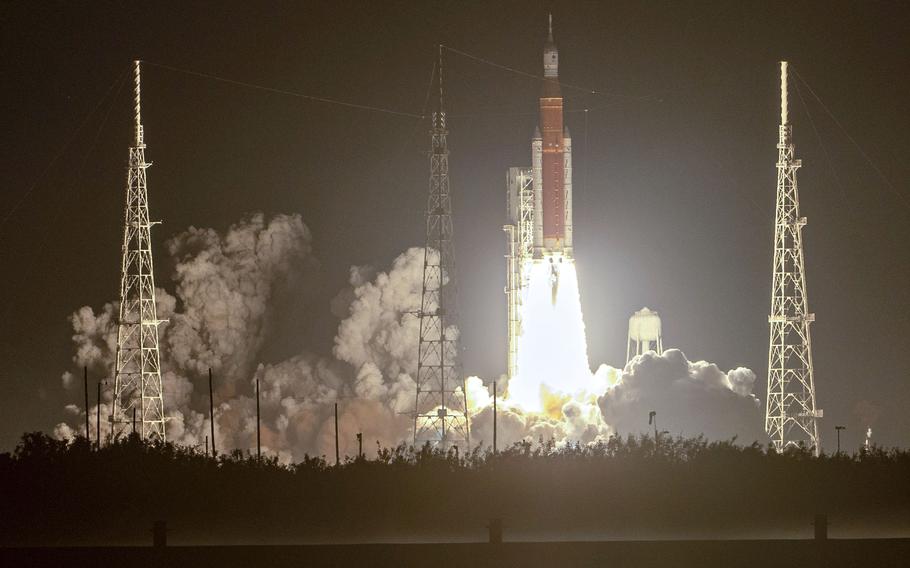
Artemis I, with the unmanned Orion spacecraft aboard, blasts off in November 2022. (Jonathan Newton/The Washington Post)
NASA is 66 years old and feeling its age. Brilliant engineers are retiring. Others have fled to higher-paying jobs in the private space industry. The buildings are old, their maintenance deferred. The Apollo era, with its huge taxpayer investment, is a distant memory. The agency now pursues complex missions on inadequate budgets.
This may be an unsustainable path for NASA, one that imperils long-term success. That is the conclusion of a sweeping report, titled “NASA at a Crossroads,” written by a committee of aerospace experts and published Tuesday by the National Academies of Sciences, Engineering and Medicine.
The report suggests that NASA prioritizes near-term missions and fails to think strategically. In other words, the space agency isn’t sufficiently focused on the future.
NASA’s intense focus on current missions is understandable, considering the unforgiving nature of space operations, but “one tends to neglect the probably less glamorous thing that will determine the success in the future,” the report’s lead author, Norman Augustine, a retired Lockheed Martin chief executive, said Tuesday.
He said one solution for NASA’s problems is more funding from Congress. But that may be hard to come by, in which case, he said, the agency needs to consider canceling or delaying costly missions to invest in more mundane but strategically important institutional needs, such as technology development and workforce training.
Augustine said he is concerned that NASA could lose in-house expertise if it relies too heavily on the private industry for newly emerging technologies.
“It will have trouble hiring innovative, creative engineers. Innovative, creative engineers don’t want to have a job that consists of overseeing other people’s work,” he said.
NASA Administrator Bill Nelson thanked the Augustine committee for the report. “This report aligns with our current efforts to ensure we have the infrastructure, workforce, and technology that NASA needs for the decades ahead,” Nelson said in a statement released by the agency. “We will continue to work diligently to address the committee’s recommendations — and drive our cutting-edge work on Earth, in the skies, and in the stars.”
Congress directed NASA to sponsor a National Academies study to review the agency’s long-term goals and mission plans after Congress passed the CHIPS and Science Act in 2022. Tuesday’s 204-page report was compiled after 25 committee sessions across 14 months.
The report is hardly a blistering screed. The tone is parental. It praises the agency — with a budget of about $25 billion — for its triumphs while urging more prudent decision-making and long-term strategizing.
NASA pursues spectacular missions. It has sent swarms of robotic probes across the solar system and even into interstellar space. Astronauts have continuously been in orbit for more than two decades. The most ambitious program, Artemis, aims to put astronauts back on the moon in a few short years. And long-term, NASA hopes to put astronauts on Mars.
But a truism in the industry is that space is hard. The new report contends that NASA has a mismatch between its ambitions and its budget, and needs to pay attention to fundamentals such as fixing its aging infrastructure and retaining in-house talent.
“NASA’s overall physical infrastructure is already well beyond its design life, and this fraction continues to grow,” the report states.
At risk, potentially, is NASA’s status as the world’s premier space agency. China has a robust space program, with lunar ambitions of its own.
The report notes that NASA’s budget has crept up in recent years, but so have costs as the missions have become more complex and ambitious. Factoring in inflation and buying power, NASA’s budget has been relatively flat.
Augustine has long been a NASA critic-at-large. He has served on multiple committees over the past several decades that have reviewed NASA’s overall health. A recurring theme: The agency bites off more than it can chew.
That was the conclusion reached by an Augustine-chaired committee convened by President Barack Obama early in his administration to review NASA’s strategy. The report said NASA did not have the resources to carry out the missions advocated by the administration of President George W. Bush, including sending astronauts back to the moon on NASA-built rockets. That led to NASA shelving the moon mission, though it was revived under President Donald Trump and has been sustained by President Joe Biden.
Lori Garver, who served as NASA deputy administrator under Obama, called the report “an excellent roadmap for any future NASA leaders who would choose to make meaningful change.” She cited the report’s observation that NASA routinely runs about $3 billion short of the funding it needs to complete its suite of missions.
“This report could not be more timely to the next NASA transition team’s efforts to realign programs for greater success,” she said in an email.